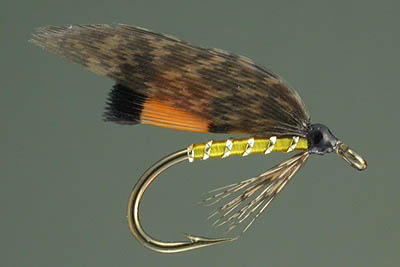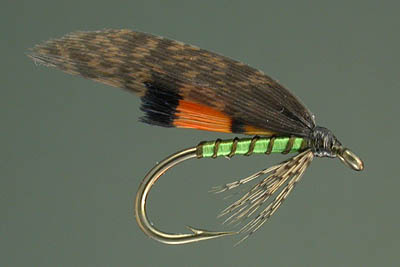|
Did the early Australian settlers fly-fish?
One would think not, they were hard workers with large
families and very few comforts. To those hardy pioneers
fishing was more than a sport; it was a way to feed the
family. Nevertheless, there actually were some fly tiers and
fly fishers even before the introduction of trout. During
the 1860s Maria Shanklin was making flies for native perch
(bass) in Gippsland waters. Maria was the eldest daughter of
Alfred Ronalds the author of the classic English work ‘The
Fly Fisher's Entomology’ published in 1836. Alfred
Ronalds and his family were lured to Australia by the
discovery of gold at Ballarat in August 1851. By 1853, there
were more than 20,000 miners of many nationalities working
on the field.
Many of those early colonists desperately
wanted trout to become established as a sport fish so they
might enjoy the sport they knew in mother England. After
much expense and many unsuccessful attempts, viable Brown
Trout ova were successfully shipped from England to
Tasmania, the island state of Australia in 1864. The progeny
of those trout were introduced into other Australian states,
Victoria in 1871–72 and in New South Wales in 1887. Let
loose in a new land of ideal conditions, the trout spawned
readily and through the process of natural migration,
populations dispersed rapidly. Having few aggressive
competitors, plus an abundant food supply, the trout grew to
record sizes.
It seems that trout flies and other fishing
gear were imported from the House of Hardy or Ogden of
Cheltenham. English fly rods and reels with braided Irish
linen line or silk were used. A lot of fishing gear was home
made, especially rods. Perhaps there were some locally made
trout flies, however research has not been able to uncover
any such patterns. Fly-fishers were scarce and bait fishing
was the popular method of fishing, particularly grasshopper
fishing in summer. Grasshopper fishing was accomplished by
flicking a live grasshopper upstream using a general-purpose
fishing rod. The problem was that they couldn't cast the
hopper far and often, the casting action would flick the
hopper off the hook, therefore a good supply of live hoppers
was always required. The scene was set for the first
Australian trout fly to be made.
In New South Wales at Jindabyne about 1896
Mr. C.R. Burnside and Dr. A.J. Bardy fished, what
is believed to be the first Australian trout fly, a
grasshopper imitation. The fly was designed to be fished wet
in accordance with the convention of the time. It is unknown
who actually tied the fly and Mr. Howard Joseland, a fishing
acquaintance, may have dressed it. Joseland states in his
book, “Angling in Australia and Elsewhere”, published
by Art in Australia Limited, Sydney, 1921. “It was first
tried” by Burnside and Bardy, not tied by them. These
gentlemen were among the pioneers of fly-fishing in
Australia and they were highly influenced by salmon flies.
The fly was
named after the Bredbo; a little stream that begins high up
in the Great Dividing Range and eventually flows into the Murrumbidgee River. Presumably this is the stream where the
fly was first fished.
Compared to the traditional sombre looking
English wet fly patterns used in those days, ‘The Bredbo’ is
a rather bright looking fly. The use of golden pheasant
tippets to represent the grasshopper legs was an extremely
groundbreaking development. It is a trait, which has been
utilised by most Australian hopper patterns ever since. In
Mary Orvis-Marbury’s classic 1892 book ‘Favorite Flies
and Their Histories’, there are no patterns whatsoever
featuring flies with legs.
--Alan
Shepherd
|
A later version of
the Bredbo. Tied by Rob Knisely |
|

Photo by Peter Frailey
|
Order of Ingredients:
Hook: Size 12
Thread: Black
Body: Yellow floss.
Rib: Gold wire
Underwing: Pheasant tippets
Wing: Speckled hen wing feather
Hackle beard: Brown partridge back
feathers tied in underneath
Note: A 1906 ‘Eastways’
catalogue quotes a yellow body, yet other
versions show orange |
|
|
Elsa Lowrie's version.
Tied by Rob Knisely |
|

Photo by Peter Frailey
Elsa Lowry:
Elsa Lowrie was a legendary
Australian fly dresser. She tied flies and
fly-fished from her early teens until she
was in her seventies. She died in 1991. She
wrote in a letter that she believed ‘The
Bredbo’ was Australia’s first trout fly.
Elsa's version:
Hook: Size 12
Thread: Black
Body: Lime green floss.
Binding: dark green floss silk
(twisted)
Hackle: Grouse
Underwing: Two triangles of golden
pheasant tippets
Overwing: Brown Turkey (speckled black)
|
|
|